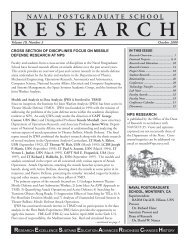Spectral Unmixing Applied to Desert Soils for the - Naval ...
Spectral Unmixing Applied to Desert Soils for the - Naval ...
Spectral Unmixing Applied to Desert Soils for the - Naval ...
Create successful ePaper yourself
Turn your PDF publications into a flip-book with our unique Google optimized e-Paper software.
While this is lower than <strong>the</strong> hoped <strong>for</strong> 15–60%, comparison of <strong>the</strong> imagery <strong>to</strong><br />
higher spatial resolution Google Earth imagery shows that <strong>the</strong>re do seem <strong>to</strong> be trails in<br />
most of <strong>the</strong> areas that were marked. O<strong>the</strong>r areas with higher MF scores between 15 and<br />
25 also yielded positive results <strong>for</strong> trails not readily seen in <strong>the</strong> imagery, but also had<br />
some false positives.<br />
Figure 30. The above figure shows <strong>the</strong> MF verses Infeasibility scatter plot <strong>for</strong> <strong>the</strong> camp<br />
road endmember result plotted on a grayscale image of <strong>the</strong><br />
f110512t01p00r07 data set with B being <strong>the</strong> zoomed in version of A. Red<br />
pixels represent target material with MF scores between 10 and 49%. The<br />
NE <strong>to</strong> SW trending pixels are thought <strong>to</strong> be a trail and have MF scores of<br />
11–12%, <strong>the</strong> NW <strong>to</strong> SE trending pixels are along a drainage and have MF<br />
scores of 16–22% but may still be trail material.<br />
62
















